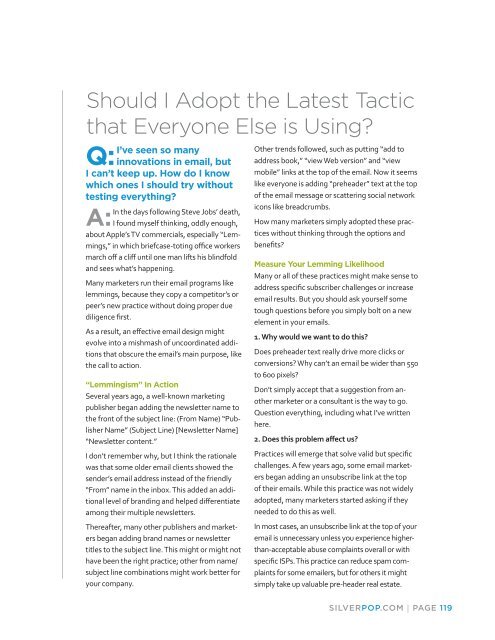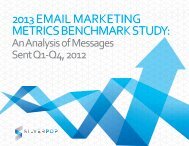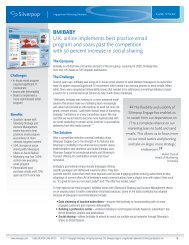eBook - Silverpop
eBook - Silverpop
eBook - Silverpop
You also want an ePaper? Increase the reach of your titles
YUMPU automatically turns print PDFs into web optimized ePapers that Google loves.
Should I Adopt the Latest Tactic<br />
that Everyone Else is Using?<br />
I’ve seen so many<br />
Q: innovations in email, but<br />
I can’t keep up. How do I know<br />
which ones I should try without<br />
testing everything?<br />
In the days following Steve Jobs’ death,<br />
A: I found myself thinking, oddly enough,<br />
about Apple’s TV commercials, especially “Lemmings,”<br />
in which briefcase-toting office workers<br />
march off a cliff until one man lifts his blindfold<br />
and sees what’s happening.<br />
Many marketers run their email programs like<br />
lemmings, because they copy a competitor’s or<br />
peer’s new practice without doing proper due<br />
diligence first.<br />
As a result, an effective email design might<br />
evolve into a mishmash of uncoordinated additions<br />
that obscure the email’s main purpose, like<br />
the call to action.<br />
“Lemmingism” In Action<br />
Several years ago, a well-known marketing<br />
publisher began adding the newsletter name to<br />
the front of the subject line: (From Name) “Publisher<br />
Name” (Subject Line) [Newsletter Name]<br />
“Newsletter content.”<br />
I don’t remember why, but I think the rationale<br />
was that some older email clients showed the<br />
sender’s email address instead of the friendly<br />
“From” name in the inbox. This added an additional<br />
level of branding and helped differentiate<br />
among their multiple newsletters.<br />
Thereafter, many other publishers and marketers<br />
began adding brand names or newsletter<br />
titles to the subject line. This might or might not<br />
have been the right practice; other from name/<br />
subject line combinations might work better for<br />
your company.<br />
Other trends followed, such as putting “add to<br />
address book,” “view Web version” and “view<br />
mobile” links at the top of the email. Now it seems<br />
like everyone is adding “preheader” text at the top<br />
of the email message or scattering social network<br />
icons like breadcrumbs.<br />
How many marketers simply adopted these practices<br />
without thinking through the options and<br />
benefits?<br />
Measure Your Lemming Likelihood<br />
Many or all of these practices might make sense to<br />
address specific subscriber challenges or increase<br />
email results. But you should ask yourself some<br />
tough questions before you simply bolt on a new<br />
element in your emails.<br />
1. Why would we want to do this?<br />
Does preheader text really drive more clicks or<br />
conversions? Why can’t an email be wider than 550<br />
to 600 pixels?<br />
Don’t simply accept that a suggestion from another<br />
marketer or a consultant is the way to go.<br />
Question everything, including what I’ve written<br />
here.<br />
2. Does this problem affect us?<br />
Practices will emerge that solve valid but specific<br />
challenges. A few years ago, some email marketers<br />
began adding an unsubscribe link at the top<br />
of their emails. While this practice was not widely<br />
adopted, many marketers started asking if they<br />
needed to do this as well.<br />
In most cases, an unsubscribe link at the top of your<br />
email is unnecessary unless you experience higherthan-acceptable<br />
abuse complaints overall or with<br />
specific ISPs. This practice can reduce spam complaints<br />
for some emailers, but for others it might<br />
simply take up valuable pre-header real estate.<br />
SILVERPOP.COM | PAGE 119







